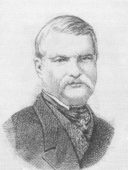
Carl Jaenisch
Encyclopedia

Vyborg
Vyborg is a town in Leningrad Oblast, Russia, situated on the Karelian Isthmus near the head of the Bay of Vyborg, to the northwest of St. Petersburg and south from Russia's border with Finland, where the Saimaa Canal enters the Gulf of Finland...
, April 11, 1813 – Saint Petersburg
Saint Petersburg
Saint Petersburg is a city and a federal subject of Russia located on the Neva River at the head of the Gulf of Finland on the Baltic Sea...
, March 7, 1872) was a Finnish
Finland
Finland , officially the Republic of Finland, is a Nordic country situated in the Fennoscandian region of Northern Europe. It is bordered by Sweden in the west, Norway in the north and Russia in the east, while Estonia lies to its south across the Gulf of Finland.Around 5.4 million people reside...
and Russia
Russia
Russia or , officially known as both Russia and the Russian Federation , is a country in northern Eurasia. It is a federal semi-presidential republic, comprising 83 federal subjects...
n chess
Chess
Chess is a two-player board game played on a chessboard, a square-checkered board with 64 squares arranged in an eight-by-eight grid. It is one of the world's most popular games, played by millions of people worldwide at home, in clubs, online, by correspondence, and in tournaments.Each player...
player and theorist. In the 1840s, he was among the top players in the world.
Life and career
He began a military career in Finland, but soon moved to RussiaRussia
Russia or , officially known as both Russia and the Russian Federation , is a country in northern Eurasia. It is a federal semi-presidential republic, comprising 83 federal subjects...
to teach rational mechanics in Petersburg (now Saint Petersburg
Saint Petersburg
Saint Petersburg is a city and a federal subject of Russia located on the Neva River at the head of the Gulf of Finland on the Baltic Sea...
). He dedicated his life to mathematics and chess, two subjects which he considered closely related. He tried to show their connections in his work Découvertes sur le cavalier (aux échecs), published in Peterburg in 1837.
In 1842–43 he published a book on the openings
Chess opening
A chess opening is the group of initial moves of a chess game. Recognized sequences of opening moves are referred to as openings as initiated by White or defenses, as created in reply by Black. There are many dozens of different openings, and hundreds of named variants. The Oxford Companion to...
in two volumes: Analyse Nouvelle des ouvertures. In 1862–63 he published his major work: Traité des applications de l'analyse mathématique au jeu des échecs, in three volumes.
He wanted to take part in the London 1851 chess tournament
London 1851 chess tournament
right|thumb|[[Adolf Anderssen]] won both the London International Tournament and the rival London Club Tournament.London 1851 was the first international chess tournament. The tournament was conceived and organised by English player Howard Staunton, and marked the first time that the best chess...
, but arrived late and instead played a match with Howard Staunton
Howard Staunton
Howard Staunton was an English chess master who is generally regarded as having been the world's strongest player from 1843 to 1851, largely as a result of his 1843 victory over Saint-Amant. He promoted a chess set of clearly distinguishable pieces of standardised shape—the Staunton pattern—that...
, which he lost (+2 –7 =1). Three years later he also lost to Ilya Shumov
Ilya Shumov
Ilya Shumov was a Russian chess master.He served as an officer in the Russian Navy until 1847, then worked as a civil servant in Sankt Petersburg. He was invited, along with two other Russian chess masters – Alexander Petrov and Carl Jaenisch, to participate in the London 1851 chess tournament but...
(+3 –5 =4).
Legacy
Jaenisch is best remembered for having analyzed and helped develop Petrov's DefencePetrov's Defence
Petrov's Defence is a chess opening characterised by the following moves:Though this symmetrical response has a long history, it was first popularised by Alexander Petrov, a Russian chess player of the mid-19th century...
with Alexander Petrov
Alexander Petrov
Alexander Dmitrievich Petrov was a Russian chess player, chess composer, and chess writer....
, and for his work on the Schliemann–Jaenisch Gambit of the Ruy Lopez
Ruy Lopez
The Ruy Lopez, also called the Spanish Opening or Spanish Game, is a chess opening characterised by the moves:-History:The opening is named after the 16th century Spanish priest Ruy López de Segura, who made a systematic study of this and other openings in the 150-page book on chess Libro del...
, which begins 1. e4 e5 2. Nf3 Nc6 3. Bb5 f5!? (3...f5!? initiates the Jaenisch Gambit.)

